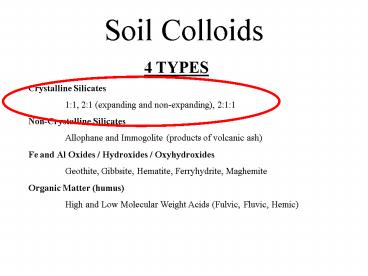Soil Colloids PowerPoint PPT Presentation
1 / 34
Title: Soil Colloids
1
Soil Colloids
4 TYPES Crystalline Silicates 11, 21
(expanding and non-expanding), 211 Non-Crystalli
ne Silicates Allophane and Immogolite (products
of volcanic ash) Fe and Al Oxides / Hydroxides /
Oxyhydroxides Geothite, Gibbsite, Hematite,
Ferryhydrite, Maghemite Organic Matter
(humus) High and Low Molecular Weight Acids
(Fulvic, Fluvic, Hemic)
2
Crystalline Silicate Claysclassified by the
ratio of the respective sheets within a layerand
by the relative charge of an individual layer
11 Kaolinite, halloysite, nacrite,
dickite 21 Smectite montmorillonite,
biedellite, nontronite Vermiculite (di- or tri-
octahedral) Fine-Grained Micas -
Illite 211 Chlorite
3
Primary Silicate Minerals
Most abundant mineral in Earths Crust Silicon
and Oxygen are 2 most abundant elements Si and O
in combination with other elements Silicate Ion
Basic Building Block SiO4-4 results in a
tetrahedron
4
Silica Tetrahedron
http//socrates.berkeley.edu/eps2/wisc/Lect4.html
5
Primary Silicate Minerals Tecto-silicates Phyllo-
silicates Ino-silicates (single
chain) Ino-silicates (double chain) Cyclo-silicat
es Neso-silicates Soro-silicates
6
Primary Silicate Minerals
Are the building blocks of igneous rocks Common
in Sand and Silt fractions Weather into
Secondary Clay Minerals
7
Mica (SEM)
Mica weathers into clay Serge Jolicoeur Universit
e de Moncton
8
Secondary Silicate Minerals
Dominate The Clay Fraction of Soils Very High
Specific Surface Areas Electrostatically Charged
Due to Isomorphous Substitution pH Dependant
Charge Variable Charge
9
Properties of Clays
10
Table of Secondary Clay Minerals
11
Structures of Secondary Silicate Minerals
From Small (atoms) to Large (soils, rocks) Why
Tetrahedron or Octahedron? Size of
Ion Composition and Combinations of
layers/sheets Chemical and Physical Properties
of Clay minerals
12
Structures of Secondary Minerals
Table 8.2 Ionic Radii and Location of Elements
Found in Silicate Clays Brady and Weil
13
Tetrahedron and Octahedron
SiO4-4
AlO6-9
14
Tetrahedral Sheet
http//www.tulane.edu/sanelson/eens211/weathering
clayminerals.htm
15
Octahedral Sheet
http//www.tulane.edu/sanelson/eens211/weathering
clayminerals.htm
16
Octahedral Sheet
Tri-octahedral vs Di-octahedral Brucite
Gibbsite
http//www.gly.uga.edu/schroeder/geol6550/CM06.htm
l
17
1 1 Phyllosilicates
18
Kaolinite
Al2Si2O5(OH)4
11 (1 Tetrahedral sheet and 1 Octahedral
sheet) H-bonding between layers no internal
surfaces No Isomorphous substitution Low
CEC CEC due to variable charge Small distance
between layers (0.72 nm) Industrial Uses
ceramics, bricks, porcelain Building Material
Non-expanding 3D visualization
19
Kaolinite (SEM)
Kaolintie growing on a Quartz Crystal
20
21 Phyllosilicates
2 Main Types Expanding Non-Expanding
Smectite Illite
Vermiculite Chlorite
21
Smectites (Smectite Family)
21 Very Expansive Mineral High
Shrink-Swell Lots of Substitution (both sheets)
High CEC Large Interlayers Internal
Surface Area Charge Balancing Cations and Water
fill interlayer space Building Hazard Sticky,
Plastic and Cohesive Montmorillonite
Na0.5(Al1.5Mg0.5)Si4O10(OH)2 - nH2O Mg replaces
Al in the octahedral sheet
22
Montmorillonite SEM
http//www.glossary.oilfield.slb.com/DisplayImage.
cfm?ID163
23
Montmorillonite SEM
http//webmineral.com/specimens/picshow.php?id128
5
24
Expanding
25
Weathering of Mica
As micas weather the interlayer will
progressively become hydrated as K is released
from the structure. Mica -----gt
Illite ----gt Vermiculite--gtSmecti
te Interlayer dehydrated paritally
hydrated fully hydrated Charge
-1 0.6-0.8 0.6-0.9 / 0.25-0.6
26
Illite
Weathering product from Muscovite (platy
structure) Isomorphous Substitution in the
Tetrahedral and Octahedral Sheets Less Layer
charge than Vermiculite Non-expanding Potassium
bound to tetrahedral layers
27
Illite SEM
28
Illite SEM
29
Vermiculite
Lots of Substitution Very High CEC Al in
octahedral sheet and substituted for Si in
Tetrahedral Sheet Large Interlayer Space High
Internal Surface Area Less Shrink Swell than
Smectites Used as a Soil Medium in nurseries and
greenhouses / insulation Weathering product of
Muscovite Chemical Formula (MgFe,Al)3(Al,Si)4O1
0(OH)2.4H2O
30
Vermiculite
Libby, Montana Mining Operation and Asbestos
Concerns
31
Chlorite
211 One 21 layer and one 11 layer
32
Chlorite SEM
33
Types of Clays
Figure 8.7 Schematic drawing illustrating the
organization of tetrahedral and octahedral sheets
in one 11-type mineral (kaolinite) and four
21-type minerals. The octahedral sheets in each
of the 21-type clays can be either aluminum
dominated or magnesium dominated. Note that
kaolinite is nonexpanding, the layers being held
together by hydrogen bonds. Maximum interlayer
expansion is found in smectite, with somewhat
less expansion in vermiculite because of the
moderate binding power of numerous Mg2 ions.
Fine-grained mica and chlorite do not expand
because K ions (fine-grained mica) or an
octahedral-like sheet of hydroxides of Al, Mg,
Fe, and so forth (chlorite) tightly bind the 21
layers together.
34
Properties of Clays

